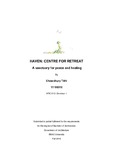Have: centre for retreat a senctuary for peace and healing

View/
Date
2015-08Publisher
BRAC UniversityAuthor
Tithi, ChowdhuryMetadata
Show full item recordAbstract
A peaceful and harmonious life can be attained when there is coherence in our mind, body and spirit. However, human beings, by nature, are social creatures. Our connection to others is key to not only our survival, but also to our happiness, well-being and success. Hence, it is not enough to focus only on individual welfare. We must also learn to nurture the relationships in our lives and foster our place in and with the community around us. Additionally, nature is an aspect of the world that has been unappreciated for far too long. Nature provides us with many benefits and is vital to our existence. Yet we fail to reciprocate any of it. We must adopt the habit ofgiving nature its due credit and learn to care and preserve it. Hence, theidea was to design a place where one could be in tune with himself, the community around him and his surroundings. Happiness and peace can only be achieved when there is an equilibrium within self, the community and nature. The objective of this paper is to put forth the thought process and methodology that went about in the design of ‗Haven: Centre for Retreat – a sanctuary for peace and healing‘.The design process initiated with a comprehensive analysis of the site and an understanding of the programme required for such a project. There is currently no existing establishment of this nature in Bangladesh. Hence, the programme was derived from various findings across the world through which the general requirements of a retreatcould be collected and modified to suit the context. Site specific functions were incorporated as well into the overall programmatic layout. The concept and design were generated in parallel. After a thorough study of the existing literature review and the needs of the project, a concept was deduced. The next phaserevolved in identifying the zoning, keeping in mind the various contexts which were applicable in the process. A continuous back and forth procedure with various developments and alterations along the way, the report finally concludes with the outcome that incorporates the volume of work conducted during the semester of Fall 2015.
